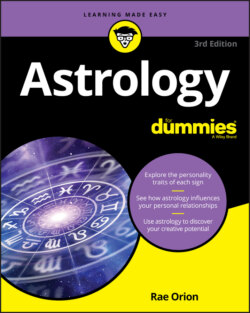Читать книгу Astrology For Dummies - Rae Orion - Страница 58
Watching the Decline of Astrology
ОглавлениеFor a long time, astronomy and astrology were braided together. Even the most important scientists of the age knew how to cast horoscopes — and some of them did it very well.
Nicolaus Copernicus (1473–1543) started the Scientific Revolution by arguing that the Earth revolved around the Sun, not the other way around. He also studied astrology and had exalted, ecstatic feelings about the Sun that were about as far from scientific as you can get.
Galileo Galilei (1564–1642) discovered the four largest moons of Jupiter, thus proving that all celestial bodies do not revolve around the Earth. This earned the ire of the Church, which accused him of heresy and sentenced him to house arrest for the rest of his life, all because he supported Copernicus. Galileo willingly cast horoscopes for his daughter, for himself — and for clients.
Johannes Kepler (1572–1630) determined the laws of planetary motion, bemoaned the importance people gave to astrology, and nonetheless cast more than eight hundred horoscopes, many with astute commentary and chillingly accurate predictions.
Even Isaac Newton (1642–1726), who discovered the universal law of gravity, entertained a certain curiosity about astrology, though he found alchemy more compelling. Newton is a transitional figure. He was so immersed in the search for the philosopher’s stone that he may have died from mercury poisoning, a side effect of his alchemical experiments, and yet his scientific and mathematical contributions were so essential that he is considered a founding father of the Age of Reason.
By the eighteenth century, the Enlightenment or Age of Reason was upon us, and astrology was often the object of ridicule. In 1708, the English satirist Jonathan Swift, author of Gulliver’s Travels, pretty much ruined the life of John Partridge, a former shoemaker, almanac writer, and astrologer whose death he “predicted” and then “reported” on the appointed date. Writing under the pseudonym Isaac Bickerstaff, Swift even composed an elegy for the man with a brief epitaph in rhyming couplets. “Here, five feet deep, lies on his back / A cobbler, star-monger, and quack,” it began. Partridge had to turn away his would-be embalmers at the door.
Nevertheless, astrology was part of everyday life, as the continuing sale of almanacs suggests. They included useful facts about weather, tides, and so on. But they were also filled with celestial information. In the British colonies of North America, Benjamin Franklin published his Poor Richard’s Almanack under the pseudonym Richard Saunders, an homage to an English astrologer who died before Franklin was born (and whose books were found in Isaac Newton’s library). Poor Richard’s Almanack, published from 1733 to 1758, sold well. Although it is known primarily for Franklin’s sensible aphorisms (“No gains without pains”), it also provides an enormous quantity of astrological data. In the very first issue, in direct imitation of Swift, Franklin predicts the death of a living person — in this case, Titan Leeds, his competitor in almanac publication. Leeds would die, Franklin wrote, “on Oct. 17. 1733. 3 ho. 29 m. P. M. at the very instant of the of and .” He knew the language of astrology, even if he mocked it.
Attitudes were changing, assisted by scientific advances. In 1781, William Herschel spotted Uranus, the first new planet discovered in recorded history. Twenty years later, astronomers discovered Ceres, originally thought to be a planet but later classified as an asteroid (although recently upgraded to dwarf planet). After Ceres came Pallas, Juno, Vesta — and eventually millions of small celestial bodies. In 1832, Neptune was discovered. And in 1835, almost three centuries after publication, the book that started it all, Copernicus’s On the Revolutions of the Heavenly Orbs, was taken off the Catholic Church’s Index of Forbidden Books. By then, astrology was no longer in fashion. Universities didn’t even offer courses in it.
